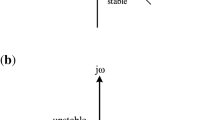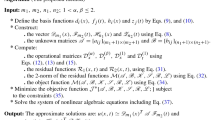Abstract
In this paper, we authors propose to use an optimization technique known as Differential Evolution (DE) optimizer for the approximation of fractional-order systems with rational functions of low order. Usual integer-order models with eleven unknown parameters are optimized to represent non-integer-order systems using the DE algorithm. Four numerical examples have illustrated the efficiency of the proposed reduced-order approximation algorithm. The results obtained from the DE approach were compared with those of Oustaloup and Charef approximation techniques for fractional-order transfer functions. They showed clearly that the proposed approach provides a very competitive level of performance with a reduced model order and less parameters.








Similar content being viewed by others
References
Bagley, R., & Calico, R. (1991). Fractional order state equations for the control of viscoelastic structures. Journal of Guidance, Control, and Dynamics, 14(2), 304–311.
Bourouba, B., & Ladaci, S. (2016). Comparative performance analysis of ag, pso, ca and abc algorithm’s for fractional pid controller. In 8th IEEE International Conference on Modelling, Identification and Control (ICMIC 2016), (pp. 960–965). 15–17 November, 2016, Algiers, Algeria https://doi.org/10.1109/ICMIC.2016.7804253.
Bourouba, B., Ladaci, S., & Chaabi, A. (2017). Mrac-based fractional order \(\text{pi}^{\lambda }\text{ d }^{\mu }\) controller tuning using moth-flame optimization approach. International Journal of Systems Control and Communications (to appear).
Bouyedda, H., & Ladaci, S. (2016). Optimal tuning of fractional order \(\text{ pi }^{\lambda }\text{ d }^{\mu }\) controllers using genetic algorithms. In 8th IEEE International Conference on Modelling, Identification and Control (ICMIC 2016), (pp. 207–212). 15–17 November, 2016, Algiers, Algeria https://doi.org/10.1109/ICMIC.2016.7804299.
Brest, J., Greiner, S., Boskovic, B., Mernik, M., & Zumer, V. (2006). Self-adapting control parameters in differential evolution: A comparative study on numerical benchmark problems. IEEE Transactions on Evolutionary Computation, 10, 646–657.
Carlson, G., & Halijak, C. (1964). Approximation of fractional capacitors \((1/s)^{(1/n)}\) by a regular Newton process. IEEE Transactions on Circuit Theory, 11(2), 210–213.
Chakraborty, U. K. (2008). Advances in differential evolution. Berlin: Springer.
Charef, A. (2006). Modeling and analog realization of the fundamental linear fractional order differential equation. Nonlinear Dynamics, 46, 195–210. https://doi.org/10.1007/s11071-006-9023-2.
Charef, A., Idiou, D., Djouambi, A., & Voda, A. (2013). Identification of linear fractional systems of commensurate order. In The 3rd International Conference on Systems and Control, (pp. 1–6). 29–31 October, 2013, Algiers, Algeria.
Charef, A., Sun, H. H., Tsao, Y. Y., & Onaral, B. (1992). Fractal system as represented by singularity function. IEEE Transactions on Automatic Control, 37(9), 1465–1470. https://doi.org/10.1109/9.159595.
Diethelm, K., & Ford, N. (2001). Numerical solution methods for distributed order differential equations. Fractional Calculus Applied Analysis, 4, 531–542.
Djamah, T., Mansouri, R., Djennoune, S., & Bettayeb, M. (2008). Optimal low order model identification of fractional dynamic systems. Applied Mathematics and Computation, 206(2), 543–554.
Djouambi, A., Charef, A., & Voda, A. (2013). Numerical simulation and identification of fractional systems using digital adjustable fractional order integrator. In The 2013 European Control Conference (ECC), (pp. 2615–2620). 17–19 July, 2013, Zurich, Switzerland.
Dzieliński, A., Sierociuk, D., Sarwas, G., Petráš, I., Podlubny, I., & Škovránek, T. (2011). Identification of the fractional-order systems: A frequency domain approach. Acta Montanistica Slovaca, 16(1), 26–33.
Hartley, T., & Lorenzo, C. (2003). Fractional-order system identification based on continuous order-distributions. Signal Processing, 83, 2287–2300.
Heaviside, O. (1971) (1922). Electromagnetic theory. vol. II. New York: Chelsea Edition.
Ichise, M., Nagayanagi, Y., & Kojima, T. (1971). An analog simulation of non-integer order transfer functions for analysis of electrode processes. Journal of Electroanalytical Chemistry and Interfacial Electrochemistry, 33, 253–265.
Khettab, K., Ladaci, S., & Bensafia, Y. (2017). Fuzzy adaptive control of fractional order chaotic systems with unknown control gain sign using a fractional order nussbaum gain. IEEE/CAA Journal of Automatica Sinica (to appear).
Kilbas, A., Srivastava, H., & Trujillo, J. (2006). Theory and applications of fractional differential equations. In J. van Mill (Ed.), North-Holland mathematics studies 204. Amsterdam: Elsevier.
Koeller, R. (1984). Application of fractional calculus to the theory of viscoelasticity. Journal of Applied Mechanics, 51, 299–307.
Ladaci, S., & Charef, A. (2006). On fractional adaptive control. Nonlinear Dynamics, 43(4), 365–378. https://doi.org/10.1007/s11071-006-0159-x.
Mandelbrot, B. (1967). Some noises with 1/f spectrum, a bridge between direct current and white noise. IEEE Transactions on Information Theory, 13(2), 289–298.
Martín, F., Monje, C., Moreno, L., & Balaguer, C. (2015). De-based tuning of \(\text{ pi }^{\lambda }\text{ d }^{\mu }\) controllers. ISA Transactions, 59, 398–407.
Matsuda, K., & Fuji, H. (1993). Optimized wave-absorbing control: Analytical and experimental results. Journal of Guidance, Control, and Dynamics, 16(6), 1146–1153.
Miller, K., & Ross, B. (1993). An introduction to the fractional calculus and fractional differential equations. New York: Wiley.
Monje, A., Chen, Y. Q., Vinagre, B., Xue, D., & Feliu, V. (2010). Fractional-order systems and controls fundamentals and applications. London: Springer.
Moreno, L., Garrido, S., & noz, M. M. (2006). Evolutionary filter for robust mobile robot localization. Robotics and Autonomous Systems, 54, 590–600.
Nazarian, P., Haeri, M., & Tavazoei, M. (2010). Identifiability of fractional order systems using input output frequency contents. ISA Transactions, 49, 207–214.
Neçaibia, A., Ladaci, S., Charef, A., & Loiseau, J. (2015). Fractional order extremum seeking approach for maximum power point tracking of photovoltaic panels. Frontiers in Energy, 9(1), 43–53. https://doi.org/10.1007/s11708-014-0343-5.
Oldham, K., & Spanier, J. (1974). The fractional calculus. San Diego: Academic Press.
Othman, M., & Al-Sabawi, E. (2013). Fractional order system identification based on genetic algorithms. Journal of Engineering Science and Technology, 8(6), 713–722.
Oustaloup, A. (1995). La dérivation non entière. Paris: Hermès.
Oustaloup, A., Levron, F., Mathieu, B., & Nanot, F. (2000). Frequency-band complex non integer differentiator: Characterization and synthesis. IEEE Transactions on Circuits and Systems I: Fundamental Theory and Applications, 47(1), 25–39.
Pan, Q., Suganthan, P., Wang, L., Gao, L., & Mallipeddi, R. (2011). A differential evolution algorithm with self-adapting strategy and control parameters. Computers & Operations Research, 38, 394–408.
Poinot, T., & Trigeassou, J. C. (2004). Identification of fractional systems using an output-error technique. Nonlinear Dynamics, 38, 133–154.
Rabah, K., Ladaci, S., & Lashab, M. (2016). Stabilization of a genesio-tesi chaotic system using a fractional order \(\text{ pi }^{\lambda }\text{ d }^{\mu }\) regulator. International Journal of Sciences and Techniques of Automatic Control and Computer Engineering, 10(1), 2085–2090.
Reyes-Melo, M., Martinez-Vega, J., Guerrero-Salazar, C., & Ortiz-Mendez, U. (2004). Application of fractional calculus to modelling of relaxation phenomena of organic dielectric materials. In IEEE International Conference on Solid Dielectrics, (pp. 530–533). Toulouse, France.
Sabatier, J., Oustaloup, A., Iturricha, A. G., & Levron, F. (2003). Crone control of continuous linear time periodic systems: Application to a testing bench. ISA Transactions, 42, 421–436.
Storn, R., & Price, K. (1997). Differential evolution-a simple and efficient heuristic for global optimization over continuous spaces. Journal of Global Optimization, 11, 341–359.
Sun, H., Onaral, B., & Tsao, Y. (1984). Application of positive reality principle to metal electrode linear polarization phenomena. IEEE Transactions on Biomedical Engineering, 31(10), 664–674.
Tang, Y., Liu, H., Wang, W., & Guan, X. (2015). Parameter identification of fractional order systems using block pulse functions. Signal Processing, 107, 272–281.
Teo, J. (2006). Exploring dynamic self-adaptive populations in differential evolution. Soft Computing—A Fusion of Foundations, Methodologies and Applications, 10, 673–686.
Yakoub, Z., Amairi, M., Chetoui, M., & Aoun, M. (2015). On the closed-loop system identification with fractional models. Circuits, Systems, and Signal Processing, 34(12), 3833–3860.
Yakoub, Z., Chetoui, M., Amairi, M., & Aoun, M. (2015). A bias correction method for fractional closed-loop system identification. Journal of Process Control, 33, 25–36.
Yang, X. S. (2014). Nature-inspired optimization algorithms. Amsterdam: Elsevier.
Zaharie, D. (2002). Critical values for the control parameters of differential evolution algorithms. In Proceedings of MENDEL2002, 8th International Conference on Soft Computing, (pp. 62–67). Czech Republic.
Zhou, S., Cao, J., & Chen, Y. (2013). Genetic algorithm-based identification of fractional-order systems. Entropy, 15, 1624–1642.
Author information
Authors and Affiliations
Corresponding author
Rights and permissions
About this article
Cite this article
Bourouba, B., Ladaci, S. & Chaabi, A. Reduced-Order Model Approximation of Fractional-Order Systems Using Differential Evolution Algorithm. J Control Autom Electr Syst 29, 32–43 (2018). https://doi.org/10.1007/s40313-017-0356-5
Received:
Revised:
Accepted:
Published:
Issue Date:
DOI: https://doi.org/10.1007/s40313-017-0356-5




